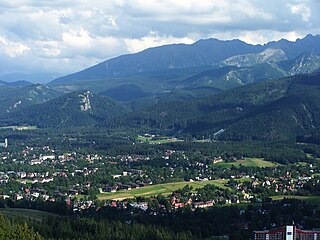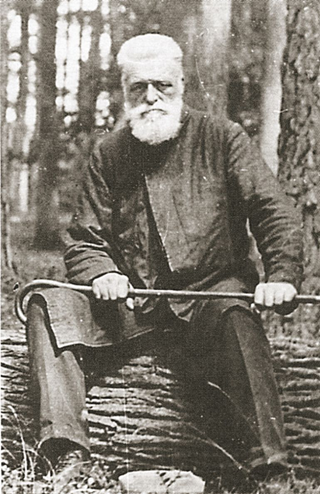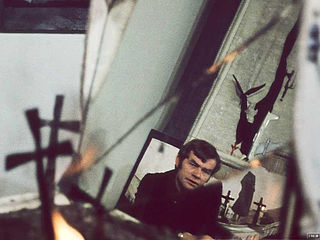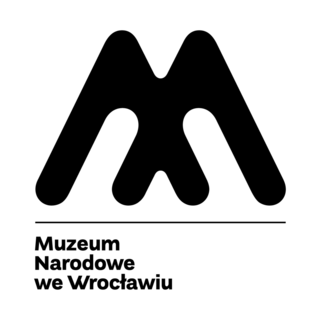
Zakopane is a town in the south of Poland, in the southern part of the Podhale region at the foot of the Tatra Mountains. From 1975 to 1998, it was part of Nowy Sącz Voivodeship; since 1999, it has been part of Lesser Poland Voivodeship. As of 2017 its population was 27,266. Zakopane is a centre of Goral culture and is often referred to as "the winter capital of Poland". It is a popular destination for mountaineering, skiing, and tourism.

Stanisław Ignacy Witkiewicz, commonly known as Witkacy, was a Polish writer, painter, philosopher, theorist, playwright, novelist, and photographer active before World War I and during the interwar period.

Stanisław Witkiewicz was a Polish painter of Lithuanian origin, art theoretician, and amateur architect, known for his creation of "Zakopane Style".

Count Władysław Zamoyski (1853–1924) was a French-born Polish nobleman (szlachcic), diplomat and heir of Kórnik, Głuchów, Janusz, Babin and Bargów. Having acquired estates on the Polish side of the Tatra Mountains and in Zakopane, he was an early ecologist and philanthropist. He was mentor to Józef Retinger, who was to become an international political activist during the two world wars and beyond, following the death of the latter's father.

Władysław Hasior was one of the leading Polish contemporary sculptors connected with the Podhale region. He was also a painter and theatre set designer.

The Gorals, also anglicized as the Highlanders and historically also as Vlachs, are an ethnographic group primarily found in their traditional area of southern Poland, northern Slovakia, and in the region of Cieszyn Silesia in the Czech Republic, where they are known as the Silesian Gorals. There is also a significant Goral diaspora in the area of Bukovina in western Ukraine and in northern Romania, as well as in Chicago, the seat of the Polish Highlanders Alliance of North America.
"National Museum of Poland" is the common name for several of the country's largest and most notable museums. Poland's National Museum comprises several independent branches, each operating a number of smaller museums. The main branch is the National Museum in Kraków, established in 1879. It has several hundred thousand items in its permanent collections, kept mostly at the Main Building at 3 Maja St., and partly in eight other divisions around the city.

Silesian Museum in Katowice is a museum in the city of Katowice, Poland.

The National Museum in Kraków, popularly abbreviated as MNK, is the largest museum in Poland, and the main branch of Poland's National Museum, which has several independent branches with permanent collections around the country. Established in 1879, the museum consists of 21 departments which are divided by art period: 11 galleries, 2 libraries, and 12 conservation workshops. It holds some 780,000 art objects, spanning from classical archeology to modern art, with special focus on Polish painting. In 2023, the museum was visited by over 1.65 million people, making it the third most-visited art museum in Poland and the 37th most-visited art museum in the world.

The Villa Atma in Zakopane, Poland, is a historic chalet housing the Karol Szymanowski Museum, department of the National Museum in Kraków.

The architecture of Poland includes modern and historical monuments of architectural and historical importance.

The National Museum in Poznań, Poland, abbreviated MNP, is a state-owned cultural institution and one of the largest museums in Poland. It houses a rich collection of Polish painting from the 16th century on, and a collection of foreign painting. The museum is also home to numismatic collections and a gallery of applied arts.
Zakopane Style is an art style, most visible in architecture, but also found in furniture and related objects, inspired by the regional art of Poland's highland regions, most notably Podhale. Drawing on the motifs and traditions in the buildings of the Carpathian Mountains, this synthesis was created by Stanisław Witkiewicz who was born in the Lithuanian village of Pašiaušė, and is now considered to be one of the core traditions of the Goral people.

National costumes of Poland vary by region. They are typically not worn in daily life but at folk festivals, folk weddings, religious holidays, harvest festivals and other special occasions. The costumes may reflect region and sometimes social or marital status.

The National Museum in Wrocław, established 28 March 1947 and officially inaugurated on 11 July 1948, is one of Poland's main branches of the National Museum system. It holds one of the largest collections of contemporary art in the country.

Art in Poland refers to all forms of visual art in or associated with Poland.
Zefiryn (Zefir) Alojzy Ćwikliński Ceferino - Polish painter, known primarily for painting in the Tatra mountains.

The Museum of Zakopane Style at Villa Koliba is a division of the Tatra Museum in Zakopane, and a museum of Zakopane style.

Sabała or Sablik was a Goral amateur musician, storyteller and folk singer active in or around the Tatra Mountains. A friend to many renowned Polish artists of the late 19th century, he is featured in numerous Polish works of art of the epoch.

Rafał Marceli Ludwik Fortunat Józef Malczewski was a Polish landscape and portrait painter, draughtsman, author and columnist. He was a noted Tatra mountaineer, skier and populariser of the Tatra Mountains.























